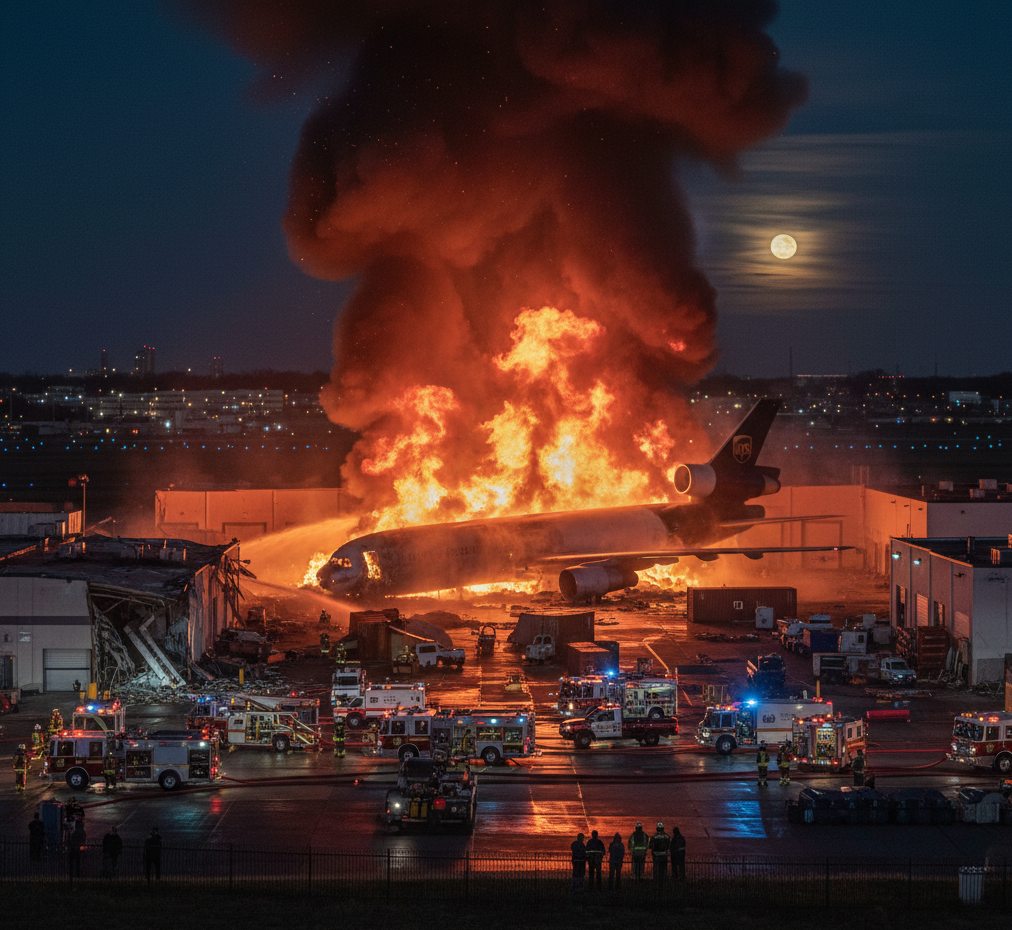On November 4, 2025, UPS Flight 2976, a McDonnell Douglas MD-11 bound for Honolulu, crashed shortly after takeoff from Louisville Muhammad Ali International Airport. Carrying 38,000 gallons of fuel, the aircraft exploded on impact, killing at least nine and injuring fifteen others. The inferno destroyed nearby businesses and forced widespread shelter-in-place orders. The NTSB launched a full investigation to determine whether mechanical failure, human error, or systemic issues contributed to the tragedy. The disaster halted UPS operations at its Worldport hub, causing major logistical disruptions and reigniting debate over cargo aviation safety following past UPS crashes in 2010 and 2013
#UPSFlight2976 #LouisvilleCrash #AviationDisaster #NTSBInvestigation #UPSAirlines #AirCargoSafety #MD11 #LouisvilleNews #FlightSafety #BreakingNew
UPS Flight 2976 Air Disaster in Louisville: Toll, NTSB Investigation and Operational Consequences
The tranquil evening sky above Louisville, Kentucky was shattered on November 4, 2025, when UPS Flight 2976 transformed from a routine cargo departure into one of the most catastrophic aviation disasters in recent American history. What should have been an uneventful takeoff toward the Hawaiian islands instead became a horrifying spectacle of flames, destruction, and tragedy that sent shockwaves through the aviation industry and devastated an entire community.
The Louisville region, intrinsically connected to UPS operations through the massive Worldport facility and thousands of local employees, found itself thrust into a nightmare scenario that tested emergency response capabilities and exposed the inherent vulnerabilities of operating massive aircraft loaded with tens of thousands of gallons of highly flammable fuel near populated areas. The disaster serves as a stark reminder that despite decades of safety improvements, aviation remains an inherently risky endeavor where mechanical failures or human errors can produce consequences of staggering magnitude.
As investigators from the National Transportation Safety Board descend upon the crash site to begin the painstaking process of reconstructing what went catastrophically wrong, the immediate focus remains on the human dimension of this tragedy—the lives lost, the families forever altered, and the community grappling with trauma and grief while simultaneously mobilizing extraordinary resources to respond to an unprecedented emergency within their midst.
I. The Event: A Catastrophic Crash at Takeoff
Flight Details and Initial Incident
The tragedy unfolded at approximately 5:15 PM local time on Tuesday, November 4, 2025, during what had begun as a seemingly routine departure from Louisville Muhammad Ali International Airport. The timing—during the busy evening departure rush—would later prove significant as witnesses across the metropolitan area observed the disaster unfold in real-time, their accounts providing crucial initial insights into the aircraft’s final moments.
UPS Flight 2976 operated using a McDonnell Douglas MD-11 trijet, an aircraft type with a complex history in commercial aviation. This particular airframe, manufactured in 1991, represented the MD-11’s early production years when the type was marketed as a fuel-efficient, long-range successor to the venerable DC-10. The aircraft had accumulated over three decades of service, raising immediate questions about maintenance history, structural integrity, and whether age-related fatigue played any role in the catastrophe.
The flight’s intended destination of Honolulu, Hawaii required the MD-11 to carry maximum fuel for the approximately 4,600-mile transpacific journey. This operational reality meant the aircraft departed Louisville carrying approximately 38,000 gallons of jet fuel—essentially transforming the cargo plane into a flying fuel tank. When disaster struck and the aircraft crashed, this massive fuel load ignited instantly, creating an inferno of such intensity that firefighters faced seemingly insurmountable challenges in bringing the blaze under control.
The sheer volume of fuel aboard created a secondary disaster beyond the initial impact. Burning jet fuel spread across the crash site, flowing into drainage systems, igniting nearby structures, and creating toxic smoke that posed immediate health hazards to anyone downwind. The explosive nature of the crash, driven by instant fuel ignition upon impact, likely contributed to the high casualty count by leaving occupants of nearby structures with virtually no time to escape.
Human Toll and Injuries
The confirmed death toll stands at a minimum of nine fatalities, though authorities have carefully noted that this number remains preliminary and could rise as recovery operations progress through the debris field. The uncertainty surrounding the final casualty count reflects the extreme destruction at the crash site, where intense fire and structural collapse have complicated victim identification and recovery efforts.
Beyond those killed instantly in the crash or subsequent fire, fifteen injured individuals were transported to UofL Health facilities for emergency treatment. The severity of injuries varied considerably, with most victims suffering from burns, smoke inhalation, traumatic injuries from flying debris, or combinations of these trauma types. Two patients remained in critical condition in intensive care units as of the latest updates, fighting for their lives with outcomes uncertain.
The nature of injuries sustained in aviation disasters involving massive fuel fires presents extraordinary treatment challenges. Burn victims require specialized care including fluid resuscitation, infection prevention, skin grafting, and long-term rehabilitation. Those suffering severe smoke inhalation face respiratory complications that can prove fatal days or even weeks after initial exposure. The medical community mobilized extensive resources to provide victims with the intensive, specialized care their injuries demanded.
The human dimension of this tragedy extends far beyond confirmed casualties and hospitalized victims. Sixteen families contacted authorities reporting missing loved ones whose whereabouts remained unknown in the disaster’s immediate aftermath. These anguished families received instructions to gather at a reunification center established at 2911 Taylor Boulevard, where crisis counselors, victim advocates, and officials worked to match missing persons reports with known casualties and provide families with whatever information, support, and resources could be offered during this unimaginable ordeal.
II. Emergency Response and Impacts on the Louisville Area
Firefighting Efforts and Property Damage
The scale of emergency response to Flight 2976’s crash represented one of the largest mobilizations in Louisville’s history, with more than 100 to 200 first responders converging on the disaster site within minutes of the initial impact. Firefighters faced extraordinary challenges combating a fuel-fed inferno that resisted conventional suppression techniques and threatened to spread to adjacent structures and neighborhoods.
The tactical challenges firefighters confronted cannot be overstated. Jet fuel burns at extremely high temperatures—often exceeding 1,500 degrees Fahrenheit—and spreads rapidly across surfaces. Water alone proves relatively ineffective against petroleum fires, requiring specialized foam agents that smother flames by creating barriers between fuel and oxygen. The quantity of burning fuel at this crash site exhausted local foam supplies, necessitating emergency deliveries from regional fire departments and military installations.
The physical destruction extended well beyond the immediate crash site. At least two businesses suffered complete destruction in the inferno, including Grade A Auto Parts & Recycling, which ironically contained additional flammable materials including oils, gasoline, and other automotive fluids that contributed to fire intensity. An oil recycling facility also sustained catastrophic damage, releasing stored petroleum products that created environmental hazards requiring immediate containment and long-term remediation efforts.
Aircraft debris scattered across a wide area, creating a dangerous landscape of twisted metal, composite materials, and potential hazardous substances. Authorities issued urgent warnings instructing area residents to avoid touching any debris, regardless of how innocuous it might appear. Aircraft wreckage can contain toxic materials including asbestos, beryllium, and various chemicals used in hydraulic systems, fire suppression, and structural components. Any debris discovered should be reported immediately to authorities rather than handled by civilians lacking appropriate protective equipment and training.
Public Consequences and Logistical Impacts
The disaster’s scope necessitated immediate protective measures for the surrounding community. Officials initially issued shelter-in-place orders covering a broad perimeter around the crash site, instructing residents to remain indoors with windows and doors closed to minimize exposure to toxic smoke and potential secondary hazards. This precautionary zone was subsequently reduced to a quarter-mile radius as air quality monitoring confirmed that dangerous smoke concentrations remained localized to the immediate crash vicinity.
The psychological impact of sheltering in place while a massive fire raged nearby, not knowing whether the danger might spread or intensify, created community-wide trauma extending far beyond those directly affected by casualties or property damage. Residents watched news coverage showing their neighborhood engulfed in flames while emergency alerts warned them against evacuating, creating profound anxiety and helplessness that will require long-term mental health support to address.
The disaster forced closure of all Jefferson County Public Schools on Wednesday, November 5, with no remote learning options provided. This decision reflected both practical concerns about staff and student availability amid the crisis and recognition that the community needed time to process the tragedy rather than attempting to maintain normal routines while emergency operations continued and families mourned loved ones.
Louisville Muhammad Ali International Airport, the departure point for the doomed flight, immediately suspended all operations following the crash. This total ground stop reflected both investigative necessity—preserving evidence and crash site integrity—and safety precautions while authorities determined whether systemic issues affecting other aircraft required addressing. One runway reopened the following morning after safety inspections confirmed it could accommodate limited operations, though full airport functionality remained compromised as the investigation unfolded.
III. Official Investigation and Corporate Response
Investigation Proceedings
The National Transportation Safety Board assumed lead investigative authority immediately following the disaster, dispatching a specialized “go-team” of investigators with expertise in aircraft systems, operations, human factors, and survival factors. The NTSB’s investigation will ultimately produce a comprehensive report identifying the crash’s probable cause, contributing factors, and safety recommendations intended to prevent similar tragedies.
The investigative process typically unfolds over months or even years, beginning with evidence collection and documentation at the crash site. Investigators will recover and analyze the flight data recorder and cockpit voice recorder—the so-called “black boxes”—which capture aircraft systems data and crew communications during the final minutes before impact. These devices, designed to survive catastrophic crashes and intense fires, provide invaluable insights into what occurred aboard the aircraft.
The Federal Aviation Administration, while not leading the investigation, provides crucial support through access to aircraft certification records, maintenance documentation, and pilot training information. The FAA’s involvement also ensures that if investigation findings reveal systemic safety issues requiring immediate attention, appropriate airworthiness directives or operational restrictions can be issued promptly rather than waiting for the final report’s completion.
As of current reporting, no official determination has been made regarding the crash’s cause. Aviation investigations resist premature conclusions, instead methodically gathering and analyzing evidence before reaching findings supported by factual documentation. Speculation about mechanical failure, pilot error, weather factors, or other potential causes remains exactly that—speculation—until investigators complete their exhaustive analysis and reach evidence-based conclusions.
UPS (United Parcel Service) Response
The disaster struck at the heart of UPS operations, occurring at the company’s most critical facility. The Louisville Worldport represents the nerve center of UPS’s global air network, processing millions of packages daily through an automated sorting system of staggering complexity and efficiency. The crash forced immediate suspension of Next Day Air sorting operations Tuesday evening, with Second-Day Air processing also canceled Wednesday.
These operational disruptions rippled throughout UPS’s network, affecting package deliveries across North America and internationally. The company scrambled to reroute volume to alternate facilities and arrange ground transportation for time-sensitive shipments, but significant delays proved unavoidable. Customers awaiting critical shipments faced uncertainty while UPS struggled to maintain service commitments amid unprecedented disruption.
UPS issued a statement expressing that the company was “devastated” by the tragedy and reaffirming commitment to safety as the organization’s highest priority. These carefully crafted words attempted to balance appropriate sympathy for victims and their families with protection of corporate interests and preservation of public confidence in the safety of UPS operations.
The disaster carries particular resonance in Louisville, a community legitimately described as a “UPS city” given the company’s massive presence. UPS Airlines maintains its headquarters at Louisville International Airport, and thousands of local residents depend on UPS for employment either directly or through the ecosystem of suppliers, contractors, and service providers supporting Worldport operations. The crash thus represented not just a corporate crisis but a community tragedy affecting friends, neighbors, and family members of victims and survivors alike.

Reminder of Major UPS Aviation Accidents
This catastrophe unfortunately represents the latest in a series of fatal accidents involving UPS cargo aircraft, raising uncomfortable questions about the carrier’s safety culture and operational practices. While cargo aviation statistically experiences higher accident rates than passenger operations—reflecting factors including older aircraft, nighttime operations, and aggressive scheduling—the frequency of UPS accidents warrants scrutiny.
The 2013 crash of UPS Flight 1354 near Birmingham, Alabama killed both crew members when the Airbus A300 impacted terrain short of the runway during a nighttime approach. NTSB investigation determined that the captain’s failure to execute a stabilized approach, combined with crew fatigue from demanding overnight scheduling, contributed to the accident. The investigation revealed systemic issues regarding crew rest requirements and fatigue management within cargo operations.
The 2010 crash of UPS Flight 6, a Boeing 747-400 operating from Dubai to Cologne, Germany, killed both pilots when an in-flight cargo fire—later determined to have originated from lithium batteries in the freight load—created smoke and fumes that incapacitated the crew and destroyed flight control systems. This tragedy led to enhanced regulations regarding lithium battery shipments and cargo fire suppression requirements, though implementation of comprehensive protective measures remains controversial within the industry.
These prior accidents established concerning patterns: inadequate crew rest and fatigue management, insufficient cargo fire protection, and potential organizational pressure prioritizing operational efficiency over safety margins. Whether similar factors contributed to Flight 2976’s crash awaits investigation findings, but the historical context creates legitimate concerns about whether UPS has fully addressed systemic vulnerabilities exposed by previous disasters.
The aviation industry operates under a “tombstone mentality” where major safety improvements typically follow catastrophic accidents that kill sufficient people to generate political will for regulatory action. Each UPS accident produced specific safety recommendations and regulatory changes addressing the particular circumstances that caused that crash. The question now facing investigators, regulators, and the industry is whether Flight 2976 exposes additional vulnerabilities requiring addressing or whether this disaster stems from circumstances that existing regulations should have prevented, suggesting implementation or compliance failures rather than regulatory inadequacy.
As Louisville grieves, families mourn, and investigators begin their methodical work, the aviation community watches closely. The findings from this investigation will likely shape cargo aviation safety practices for years to come, potentially preventing future tragedies through lessons learned at terrible cost. For the victims and their loved ones, no investigation findings or safety improvements can restore what was lost, but perhaps their sacrifice can contribute to preventing others from suffering similar fates in the future.
A UPS plane with 3 crew members crashed near …
UPS plane crash death toll rises to at least 9, officials say
UPS Statement on Aircraft Accident




